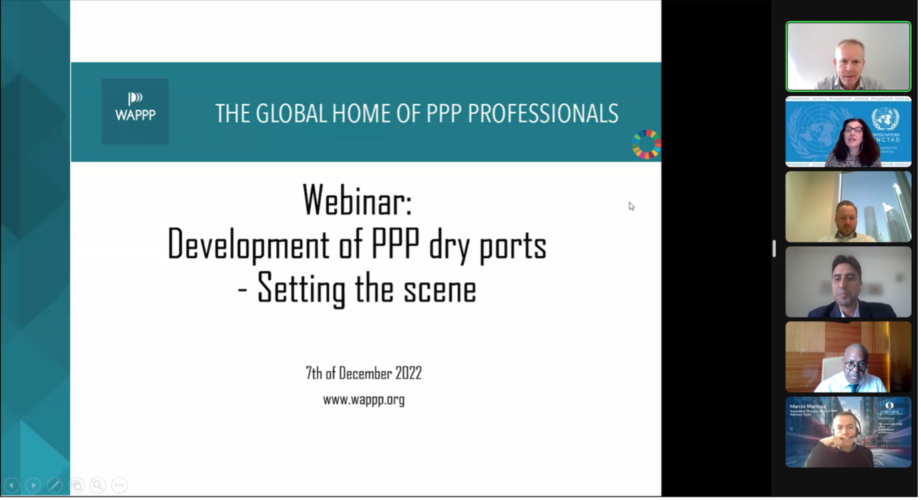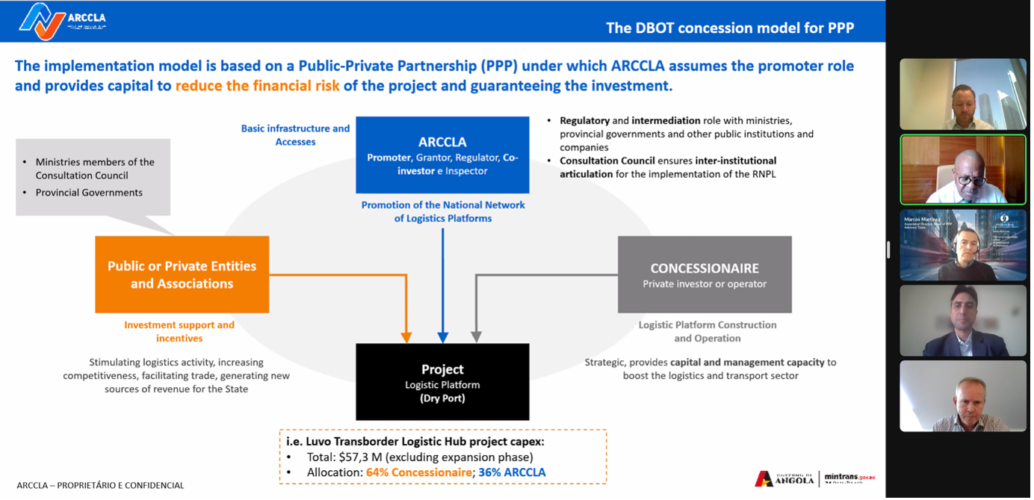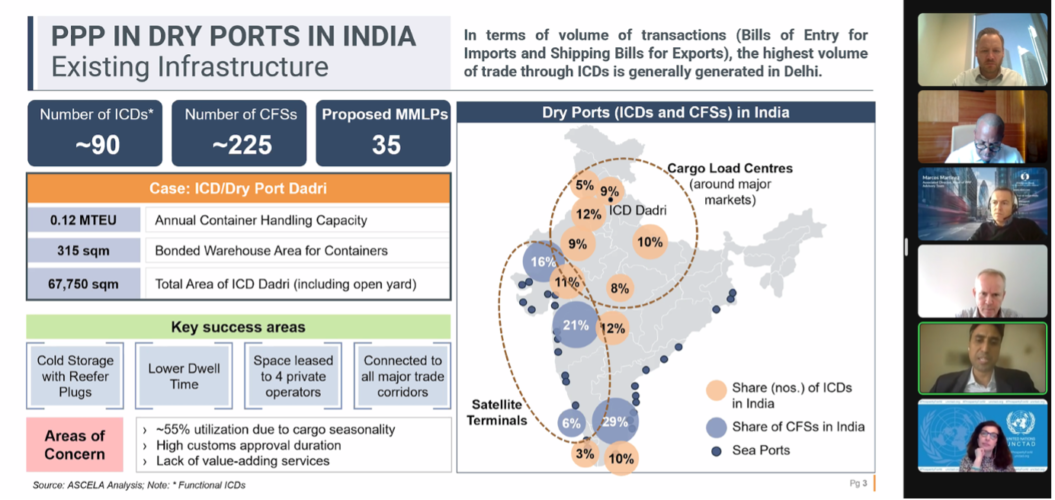On December 7, 2022, a round table “Development of PPP dry ports, key features & challenges, showcased with examples from Angola, Egypt & India” took place. It was organized by the World Association of PPP Units & Professionals (WAPPP).
Development of one or more dry ports can be a way to further improve the logistics and supply chain efficiency of a country by reducing congestion at the seaports and improving the reliability of cargo transport between the dry port and shipper/importer, given the dry port facility’s potential proximity to the final market.
Over the last three decades, Public-Private Partnerships (PPPs) have emerged as a mechanism to leverage greater private investment participation in port development. Ports and terminals benefit from the participation of private port operators, not only in terms of capital contribution, but also in relation to the transfer of expertise and technologies. Private partners are often engaged via the use of port concessions.

Mr. Erik Wehl, Chair WAPPP Port Chapter, introduced the general concept of a dry port to the participants.
The underlying principle of a dry port is to operate as an extension to one or more seaports, where activities such as customs clearance, storage, empty container handling, and various other activities can take place. As a result, yard capacity at the seaports is freed up, thereby realizing additional seaport capacity.
Often, a logistics center is developed adjacent to the dry port, which should have a complementing nature with the dry port activities, where the dry port focuses on the area of intermodal/multimodal transport and handling of cargoes and containers, whereas the logistics center will offer mainly space for warehouses, large-scale logistics and services, and so forth.
Potential direct benefits – Examples:
- Relieving congestion at busy seaports by freeing up container yards and storage space
- Economies of scale in distribution to end-users due to the efficiency of a rail link
- Decrease truck traffic at seaports
- Potential improvement in empty container logistics
Potential indirect benefits – Examples:
- Support economic development within specific regions surrounding the dry port
- Reduction of congestion around the seaports
- Reduction of negative externalities of hinterland transport emissions and facilitates freight modal shift
At the same time, Mr. Erik Wehl emphasized that it is very important to properly structure PPP projects (including from the point of view of commercial feasibility), considering that dry ports represent an extra node in the supply chain.
Mr. Catarino Pereira, Chairman at ARCCLA (the Angolan Cargo and Logistics Regulatory Agency), spoke about Angola’s experience.
In Angola ARCCLA was established to develop the logistics sector – including air, sea, rail, and road transportation. ARCCLA also assumes the relevant and important function of supervising and managing the system of the National Network of Logistics Platforms (NNLP) and identifying strategies that enhance the logistical activity and the integration of the different modes of transport.
National Network of Logistics Platforms (NNLP) is an integrated cluster of Logistic platforms (LPs), whose strategic location and operation will guarantee the optimization of the logistics network in Angola and the integration of different means of transportation. The catchment area of each LP will benefit from a dynamic effect created by the expected economies of scale and cost reductions of the logistics services, which will be consolidated in the platforms.
The implementation model is based on a Public-Private Partnership (PPP) under which ARCCLA assumes the promoter role and provides capital to reduce the financial risk of the project and guaranteeing the investment. The concessionaire is responsible for the construction and operating a logistics platform, forming a strategy, providing capital, and creating management capacity to boost the logistics and the transport sector.
At the same time, ARCCLA ensures the existence of key elements of the adjacent infrastructure (e.g., energy, multimodal access) in each LP, providing private investors with the necessary conditions and infrastructures to promote the development of the platforms.

Mr. Marcos Martinez, Head of EBRD PPP-Advisory Unit, talked about how the European Bank for Reconstruction and Development (EBRD) supports the development of new dry ports in Egypt.
As a country with a growing population and economy, Egypt needs urgent investment in its infrastructure capacity to alleviate the pressure on existing ports, shipment points and trade centres. New facilities are required to reduce congestion, allow for a better distribution of goods and let trade flow freely. A key element in this chain are dry ports, inland intermodal terminals directly connected by road or rail to a seaport, operating as centres for the shipment of sea cargo to inland destinations. Egypt’s latest transport master plan calls for the development of nine dry port and logistics centres throughout the country under PPP structures.
The European Bank for Reconstruction and Development (EBRD) is supporting the construction of the first inland dry port in Egypt, in 6th of October City, west of Cairo, with a €25 million loan to October Dry Port Company, a special-purpose vehicle established by a consortium of El Sewedy Electric, Schenker Egypt and SLP Logistics (the agreement was signed on September 9, 2021).
The development and construction of the 6th of October Dry Port (DP6) is the first public-private partnership (PPP) project in the sector and the first under the EBRD Green Cities programme in Egypt.
Mr. Jesper H. Boll, Managing Director Logistics Value Chain at ARISE, talked about the experience of implementing projects by ARISE Group in Africa as a leading developer, in particular about the PIA (Adetikope industrial platform) Dry Port in Togo. The dry port or inland container depot occupies 20 ha out of the 400 ha the PIA spans and can receive 12,500 containers. The PIA is the fruit of a partnership between ARISE Integrated Industrial Platforms and the Togolese Republic. The platform, which cost CFA130 billion, was inaugurated on June 6, 2021.Mr. Nivesh Chaudhary, Co-founder and Managing Director Infrastructure Advisory at ASCELA, reported on the experience of preparing and implementing PPPs for dry port projects in India.

To improve connectivity between the gateway seaports and inland dry ports located in the heartland, the Government of India has embarked on various connectivity projects.
The Government of India is looking at reducing the number of dry ports in the country to facilitate direct port delivery. The transformation of capable dry ports into logistics parks is underway, as well as integration with shipping lines. Shipping lines and terminal operators are now investing in developing dry ports in the region to improve logistics optimization. This is also leading to high market competition.
As a whole, the Indian dry port industry is undergoing a business model change and moving towards the concept of Smart Logistics Infrastructure, i.e., optimum and efficient space utilization, reduced cost of logistics operation, automation, real-time tracking, etc.
Key success criteria for the development of dry ports
For successful implementation of one or more dry ports, the PPP-Unit or other Government Agency needs to consider the following key aspects amongst others:
- Each dry port should be well-connected to a seaport with an effective road connection, railway line, or inland waterway, with robust interface agreements in place among various relevant stakeholders
- Custom clearance should only take place once (at the dry port for both import/ export cargo)
- The dry port should offer appropriate competitive advantage (location, hinterland accessibility, services, pricing) as it represents an extra node in the overall supply chain and thus, per see, includes additional handling activities
- Effective governance structure needs to be in place under which the project is to be implemented, and an experienced private partner should preferably manage and operate the dry port
A round table was documented in a video and is available on the Secretariat WAPPP Youtube channel: